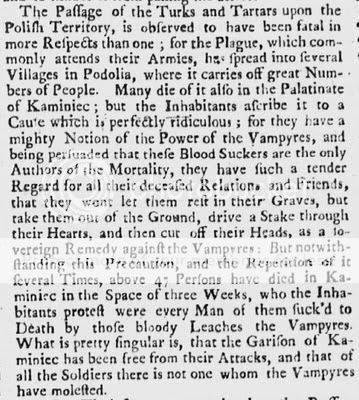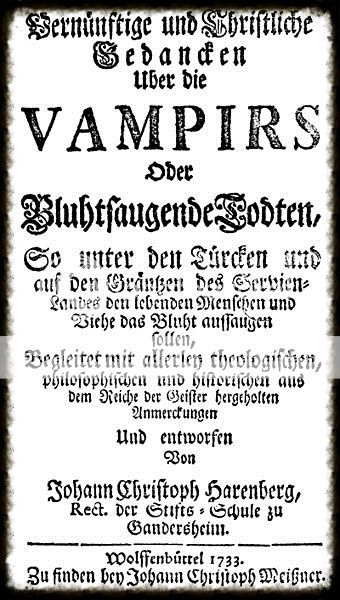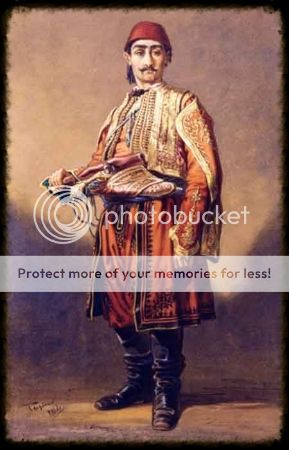If you are using Chrome, click the red hand button at the top right of the screen:

Then select: Don't run on pages on this site
If you do it correctly, the red hand will turn to green and you will no longer see this message.
Three discoveries
In the last few days, I've stumbled on a few items which challenge my views on vampire 'history'. For instance, I thought the 1991 role-playing game—Vampire: the Masquerade—was the first attempt at linking Cain with vampires.
Cain—son of Adam and Eve—murdered his brother, Abel, and was subsequently cursed by God: 'And now art thou cursed from the earth, which hath opened her mouth to receive thy brother's blood from thy hand; When thou tillest the ground, it shall not henceforth yield unto thee her strength; a fugitive and a vagabond shalt thou be in the earth' (Genesis 4: 11–12).
After Cain protests his punishment as something more than he can bare; fearing he could be killed in turn, he is 'protected' thusly: 'And the LORD said unto him, Therefore whosoever slayeth Cain, vengeance shall be taken on him sevenfold. And the LORD set a mark upon Cain, lest any finding him should kill him' (v. 15).
Cain's curse and vagabond status morphed into vampirism within Vampire: the Masquerade's mythos. Indeed, according to the game's backstory, he's the world's first vampire.
As it turns out, the link between vampires and Cain was made much earlier. More than a hundred years before, J. Theodore Bent's assessment of the Greek Βρονκόλακες mentioned: 'In Karpathos they call these beings "Cains," affirming that Cain, who slaughtered Abel on his death, became the first wandering vampire.'1
Not only that, but there's also a link between them and the vampire 'species' featured in the previous post: 'They here mix them up with another species of hobgoblin, evil spirits formed like men, with asses' or goats' feet, which appear on the earth for ten days only, from Christmas to Epiphany, during which time they subsist, like the Amazons of old, on snakes and lizards.'2
Our modern conception of vampires stems largely from Bram Stoker's Dracula (1897). One notable aspect includes vampires turning into bats. Everyone knows that trope, but they probably don't know it originated with Stoker's novel—or did it?
Earlier this year, I found a pre-Dracula reference to vampires turning into bats in an 1892 newspaper article. That is, an article reproduced in a book by Christopher Rondina. But, I had my suspicions and double-checked the original source. It turned out to be a hoax, as its author confirmed: 'As an avid vampire fan, I was also disappointed to see the absence of bats in the original folklore, and I inserted the reference into the 1892 article as a vanity "enhancement" for my own satisfaction.'
No need for disappointment. I found a vampires-into-bats reference pre-dating his own 'enhancement'—by nearly 20 years: 'The belief that human beings were sometimes changed into the bats called vampyres is found in India, and was also Magian.'3 This isn't quite the same thing, though. The passage refers to people changing into vampire bats, not that they were vampires, per se. However, I suspect that, too, is a misnomer: vampire bats are not native to India.
The article's anonymous author may have conflated vampire bats and their supposed morphic capabilities with a popular retelling of Baital Pachisi—Richard F. Burton's Vikram and the Vampire; or, Tales of Hindu devilry (1870). The so-called 'vampire'—baital or vetala—is actually an 'evil spirit which animates dead bodies'.4 No mention of blood-drinking.
The bat connection's found in its appearance: 'Its body was thin and ribbed like a skeleton or a bamboo framework, and as it held on to a bough, like a flying fox,'5 on which Burton elaborates, 'A large kind of bat ; a popular and silly Anglo-Indian name.'6
Far from vampiric, the flying fox's diet is given away by its other name—fruit bats. 'They live in the tropics and subtropics of Asia (including the Indian subcontinent)', whereas vampire bats are notably smaller and found in 'the Americas, ranging from Mexico to Brazil, Chile, and Argentina.'
What's the connection between flying foxes and vampires? The Indian Flying-fox is a member of the Pteropus vampyrus species.
A popular theory explaining the origin of the vampire belief concerns plagues. One proponent, Olga Hoyt, wrote, 'A more cogent reason for the spread of vampirism throughout Europe, beginning in the Middle Ages, however, was the was the terrible plague [Black Death] that began in the thirteenth century and lasted until the eighteenth.'7
Vampirism acted as a sort of supernatural epidemic, spreading from village to village, as seen in the Plogojowitz and Paole cases. It's not hard to see parallels, but few have established direct connections between vampire belief and the plague.
Well, I found one. A missing link. The Daily Gazetteer (6 September 1738)8 covered the movement of Turkish troops 'posted near Inharlick' towards Raskow, to head off a Russian contingent marching towards a strategically important river. Here's what happened next:

This week I had the unpleasant surprise to find some articles in the database that were referring to vampires and contain a lot of misinformation. The biggest surprise is that they were added by PAGAN one of the most proeminent, intelligent and funny VR member.
Maybe she did just like others and added a lot of junk in the database to increase her level. There is a useful rule in the database also: anything related with vampirism goes, even if it`s false. That is a good rule as some good information can be hid sometimes in strange articles and also the myth gains new value being nursed with superstition and fantasy even in this century.
Still some things must be said about such things when they misinform the reader even if I doubt too many people read such articles.
One of them can be found in the article "Incubi/Succubi and Vampires":
https://www.vampirerave.com/db/entry.php?id=28857&category=6
The phrase states:
"The vampires in Moldavia, Wallachia and Transylvania (now part of Romania) were commonly called strigoi (the singular form is strigo)"
This is so wrong that becomes funny. The plural of strigoi is strigoi because it`s a defective noun(in Romanian defectiv de plural):
un strigoi (one strigoi)
doi strigoi (two strigoi)







Does Silvia Colloca tell you something?
If not, then I`ll tell you: she is the Italian actress who played Verona, one of Dracula`s wives in Van Helsing 2004 movie.

https://www.youtube.com/watch?v=lbitdbgrUYs


COMMENTS
-